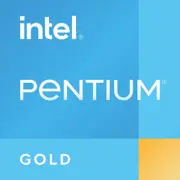Intel Pentium Gold G5600

Intel Pentium Gold G5600: A Budget Processor for Basic Tasks in 2025
Updated: April 2025
Key Specifications: Miniature Coffee Lake
The Intel Pentium Gold G5600 processor, released in 2018, remains a popular choice for budget builds thanks to its balance of price and functionality.
Architecture and Process Technology
- Codename: Coffee Lake (14 nm).
- Cores and Threads: 2 cores, 4 threads (Hyper-Threading).
- Frequency: Base – 3.9 GHz, no turbo boost.
- Cache: L3 – 4 MB.
- Integrated Graphics: Intel UHD Graphics 630 (base frequency – 350 MHz, max – 1.1 GHz).
Despite the outdated 14-nm process technology (as 7-nm and 5-nm chips dominate in 2025), the processor remains relevant for less demanding tasks. Hyper-Threading allows for more efficient workload distribution, particularly when using office applications and web browsers.
Performance
- Single-threaded: High for its class (similar to the Core i3-8100).
- Multi-threaded: Limited by two cores. Cinebench R23 test: ~2200 points (for comparison, Ryzen 3 3200G – ~3700).
- Graphics: UHD 630 handles 4K video (H.265/VP9) and light gaming (CS:GO – 40-50 FPS on low settings, Minecraft – 60 FPS).
Key Features:
- Supports DDR4-2400.
- Intel Quick Sync Video technology (video encoding acceleration).
- Energy efficiency (TDP 54 W).
Compatible Motherboards: A Cautious Choice
The Pentium G5600 uses the LGA 1151 (v2) socket, but not all motherboards with this socket are compatible.
Chipsets
- H310/B360/H370: Budget options (starting at $50). Suitable for basic builds (no overclocking).
- Z370/Z390: For enthusiasts, but excessive for Pentium (prices starting from $120).
Example Boards for 2025:
- ASUS Prime H310M-K R2.0 ($55): Minimal ports but stable operation.
- Gigabyte B360M DS3H ($70): 4 DDR4 slots, M.2 for NVMe.
Important: 200-series chipset boards (e.g., H270) do not support Coffee Lake!
Supported Memory: DDR4 and Dual-Channel Mode
- Type: Only DDR4 (up to 2400 MHz).
- Maximum Capacity: 64 GB (dependent on motherboard).
- Recommendations:
- 8 GB (2x4 GB) for office and internet use.
- 16 GB (2x8 GB) for multimedia (e.g., 1080p editing in Shotcut).
Tip: Use dual-channel mode to boost UHD 630 graphics performance by 15-20%.
Power Supply: Minimizing Costs
With a TDP of 54 W, the Pentium G5600 does not require a powerful PSU:
- Without a discrete graphics card: 300-350 W (e.g., be quiet! System Power 10 350W – $45).
- With a GTX 1650 level graphics card: 450 W (EVGA 450 BR – $55).
Calculation for a Build with GTX 1650:
- Processor: 54 W.
- Graphics Card: 75 W.
- Others: 50 W.
Total: ~180 W. A 400 W power supply will suffice.
Pros and Cons: Who is Pentium Gold Relevant For?
Advantages:
- Price: $80-100 (new, April 2025).
- Energy Efficiency: Ideal for compact PCs.
- UHD 630 Graphics: Better than AMD Athlon 3000G (Vega 3).
Disadvantages:
- 2 Cores: Multitasking is limited (streaming + gaming = lags).
- No PCIe 4.0/5.0: Max SSD speed – 3.5 GB/s (PCIe 3.0 x4).
- Outdated Platform: No upgrade path to newer processors (last option – Core i9-9900K).
Use Scenarios: Where is Its Power Sufficient?
1. Office and Study:
- Working with documents, Zoom, and 20+ browser tabs (with 16 GB RAM).
2. Multimedia:
- Watching 4K on YouTube, video editing in 1080p (with 16 GB RAM and SSD).
3. Gaming:
- Indie projects (Hollow Knight, Stardew Valley), emulators (PS2/GameCube).
- With a discrete graphics card (GTX 1650): GTA V – 60 FPS (1080p, medium settings).
Real User Experience:
A Reddit user built a PC with G5600 + GTX 1650 for their child: “Fortnite runs at 60 FPS in 1080p – it works, but in multiplayer scenes, it sometimes drops to 40 FPS.”
Comparison with Competitors: What to Choose in 2025?
1. AMD Athlon 3000G ($60):
- Pros: Unlocked multiplier, supports DDR4-2666.
- Cons: Vega 3 weaker than UHD 630.
2. Intel Celeron G5905 ($50):
- Pros: Cheaper.
- Cons: 2 cores/2 threads, UHD 610.
3. Used Core i5-7400 ($40-50):
- Pros: 4 cores.
- Cons: No support for DDR4-2400, old platform.
Conclusion: The Pentium G5600 outperforms new AMD budget options in graphics but falls short in multi-threading.
Practical Assembly Tips
1. Motherboard: Choose B360/H310 with M.2 for a fast SSD (e.g., Kingston A2000 500 GB – $45).
2. Cooling: The stock cooler is sufficient (temperature under load – up to 65°C).
3. Upgrade: The best option for this platform is the Core i5-9400 (6 cores, $120 used).
4. Case: Mini-ITX (e.g., Cooler Master Elite 110 – $60) for HTPCs.
Example Build for $300:
- Processor: G5600 ($90).
- Motherboard: ASUS H310M-K ($55).
- Memory: 8 GB DDR4-2400 ($30).
- SSD: 256 GB NVMe ($35).
- PSU: 400 W ($45).
- Case: $45.
Final Conclusion: Who is the Pentium Gold G5600 Suitable For?
This processor is a good choice if:
- Budget is limited ($300-400 for the entire PC).
- A PC for office, study, or media center is needed.
- Use of an entry-level discrete graphics card is planned.
Why not AMD? In 2025, even budget Ryzen (e.g., Ryzen 3 5300G) starts at $130, but their performance is 2-3 times higher. However, if the goal is maximum savings, the G5600 remains a valid option.
Conclusion: An outdated yet still viable processor for non-demanding users.
Basic
CPU Specifications
Memory Specifications
GPU Specifications
Miscellaneous
Benchmarks
Compared to Other CPU
Share in social media
Or Link To Us
<a href="https://cputronic.com/en/cpu/intel-pentium-gold-g5600" target="_blank">Intel Pentium Gold G5600</a>